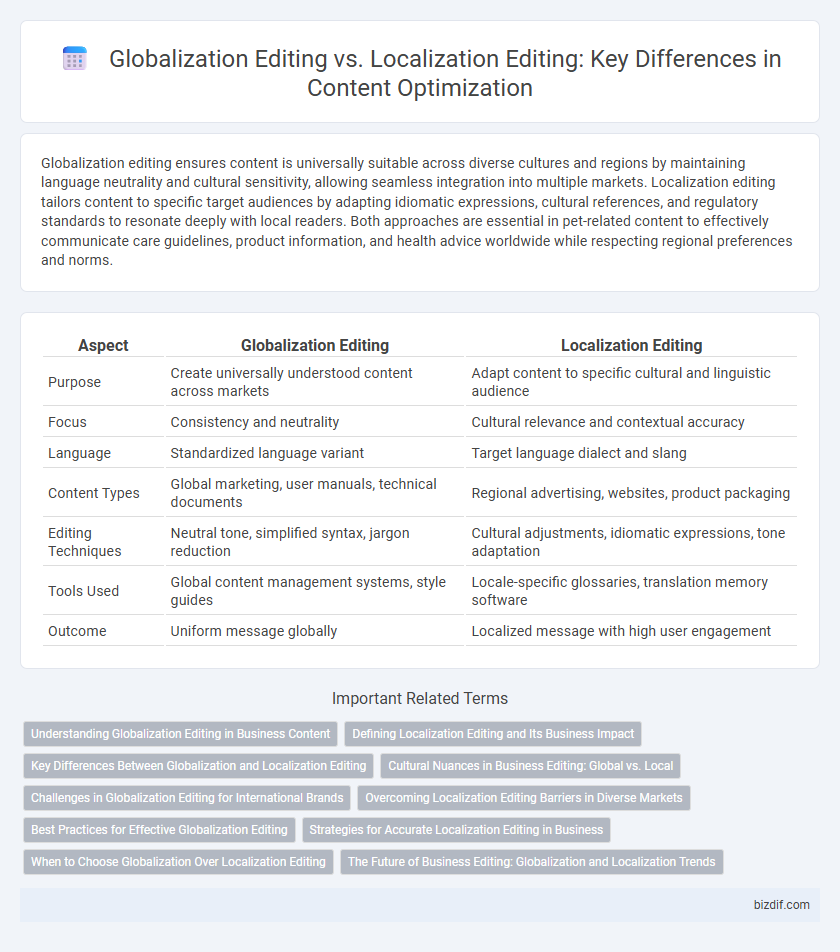Globalization editing ensures content is universally suitable across diverse cultures and regions by maintaining language neutrality and cultural sensitivity, allowing seamless integration into multiple markets. Localization editing tailors content to specific target audiences by adapting idiomatic expressions, cultural references, and regulatory standards to resonate deeply with local readers. Both approaches are essential in pet-related content to effectively communicate care guidelines, product information, and health advice worldwide while respecting regional preferences and norms.
Table of Comparison
| Aspect | Globalization Editing | Localization Editing |
|---|---|---|
| Purpose | Create universally understood content across markets | Adapt content to specific cultural and linguistic audience |
| Focus | Consistency and neutrality | Cultural relevance and contextual accuracy |
| Language | Standardized language variant | Target language dialect and slang |
| Content Types | Global marketing, user manuals, technical documents | Regional advertising, websites, product packaging |
| Editing Techniques | Neutral tone, simplified syntax, jargon reduction | Cultural adjustments, idiomatic expressions, tone adaptation |
| Tools Used | Global content management systems, style guides | Locale-specific glossaries, translation memory software |
| Outcome | Uniform message globally | Localized message with high user engagement |
Understanding Globalization Editing in Business Content
Globalization editing in business content ensures that materials are universally understandable and culturally neutral, facilitating seamless communication across diverse international markets. It involves adapting language, tone, and format without altering core messages to accommodate a global audience, enhancing brand consistency and market reach. This process contrasts with localization editing, which customizes content to fit specific regional preferences and cultural nuances.
Defining Localization Editing and Its Business Impact
Localization editing involves adapting content to meet the linguistic, cultural, and regulatory requirements of a specific target market, ensuring relevance and resonance for local audiences. This process includes translating text, adjusting idiomatic expressions, formatting dates and currencies, and modifying visuals to align with local preferences and legal standards. Effective localization editing enhances user experience, increases market penetration, and boosts brand credibility, directly impacting global business growth and customer loyalty.
Key Differences Between Globalization and Localization Editing
Globalization editing ensures content is universally appropriate, addressing cultural neutrality, language variations, and compliance with international standards to create materials suitable for diverse global audiences. Localization editing adapts content to fit specific regional or cultural contexts, incorporating local idioms, customs, legal requirements, and cultural nuances to enhance relevance and engagement. The key difference lies in globalization editing focusing on broad accessibility and consistency, while localization editing prioritizes cultural specificity and market-targeted customization.
Cultural Nuances in Business Editing: Global vs. Local
Globalization editing ensures content is universally accessible by standardizing language and cultural references to appeal to a broad international audience. Localization editing adapts content to reflect specific cultural nuances, idioms, and business practices of a target region, enhancing relevance and engagement. Emphasizing cultural nuances in business editing improves communication effectiveness, builds trust, and fosters stronger relationships in both global and local markets.
Challenges in Globalization Editing for International Brands
Globalization editing for international brands faces challenges such as maintaining brand consistency across diverse markets while adapting content to varied cultural norms and languages. Editors must navigate complex linguistic nuances and regional preferences without diluting the core brand message. Ensuring compliance with local regulations and avoiding culturally insensitive content are critical hurdles in delivering globally relevant and effective communications.
Overcoming Localization Editing Barriers in Diverse Markets
Overcoming localization editing barriers in diverse markets requires a deep understanding of cultural nuances, language variations, and regional preferences to ensure content relevance and accuracy. Employing native editors and leveraging advanced localization tools enhances the adaptation process, reducing misinterpretations and cultural insensitivity. Effective localization editing drives global engagement, improves brand consistency, and supports seamless market entry strategies.
Best Practices for Effective Globalization Editing
Effective globalization editing ensures content resonates universally by maintaining cultural neutrality and linguistic clarity across diverse audiences. Best practices emphasize thorough research of target markets, consistent terminology usage, and rigorous quality assurance to prevent misinterpretations. Employing native linguistic experts and leveraging localization technology enhances global content adaptation while preserving brand voice and message integrity.
Strategies for Accurate Localization Editing in Business
Strategies for accurate localization editing in business involve adapting content to reflect local culture, language nuances, and market preferences while maintaining the original message's intent. Utilizing professional native editors and implementing rigorous quality assurance processes ensure linguistic accuracy and cultural relevance. Leveraging localization tools and continuous feedback loops from target audience testing further enhances the effectiveness of localization editing strategies.
When to Choose Globalization Over Localization Editing
Choose Globalization Editing when targeting a broad, international audience to ensure content is culturally neutral and universally understandable. It emphasizes consistency, compliance with global standards, and avoids region-specific references that may alienate diverse readers. This approach enhances brand cohesion and streamlines communication across multiple markets without the need for extensive regional customization.
The Future of Business Editing: Globalization and Localization Trends
Globalization editing requires adapting content for a diverse international audience by ensuring cultural relevance and maintaining brand consistency across multiple languages. Localization editing goes deeper by tailoring content to specific regional dialects, customs, and legal requirements, enhancing user engagement and compliance. Future business editing trends emphasize integrating AI-driven linguistic tools that balance global coherence with localized nuance to drive market expansion and customer satisfaction.
Globalization Editing vs Localization Editing Infographic

 bizdif.com
bizdif.com